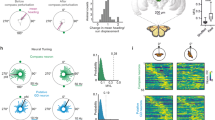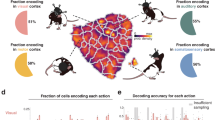Abstract
IT is known that bees, like humans, can learn the orientation of a striped pattern, and recognize this orientation in other simple patterns that they have never previously encountered1,2. How is orientation analysed by the insect visual system? In the light of what is known about animal vision, there are two obvious possibilities. First, orientation could be determined purely in terms of the directional movement signals that the pattern generates as the bee approaches it or flies past it3,4. Such a scheme would fit in well with the common supposition that much of insect vision relies solely on motion cues4,5. An alternative view, not considered for insect vision so far, would be that specific features of the pattern, such as bars or edges, are extracted and their orientation analysed as in the mammalian cortex. Our findings argue strongly against the first and for the second possibility. They suggest that similar principles underlie the analysis of pattern orientation in insects and higher vertebrates.
This is a preview of subscription content, access via your institution
Access options
Subscribe to this journal
Receive 51 print issues and online access
$199.00 per year
only $3.90 per issue
Buy this article
- Purchase on Springer Link
- Instant access to full article PDF
Prices may be subject to local taxes which are calculated during checkout
Similar content being viewed by others
References
van Hateren, J. H., Srinivasan, M. V. & Wait, P. B. J. comp. Physiol. A 167, 649–654 (1990).
Wehner, R. J. Insect Physiol. 17, 1579–1591 (1971).
Srinivasan, M. V. & Lehrer, M. J. comp. Physiol. A 162, 159–172 (1988).
Horridge, G. A. Phil. Trans. R. Soc. Lond. B 331, 199–204 (1991).
Exner, S. Die Physiologie der Facettirten Augen von Krebsen und Insecten (1981) (trans. Hardie, R. C., Springer, Berlin 1989).
Hausen, K. & Egelhaaf, M. in Facets of Vision (eds Stavenga, D. G. & Hardie, R. C.) 391–424 (Springer, Berlin 1989).
Riggs, L. A., Ratliff, F., Cornsweet, J. C. & Cornsweet, T. N. J. opt. Soc. Am. 43, 495–501 (1953).
Ditchburn, R. W. Eye Movements and Visual Perception (Clarendon, Oxford, 1973).
Hubel, D. H. & Wiesel, T. N. J. Physiol. Lond. 195, 215–243 (1968).
O'Carroll, D. Nature 362, 541–543 (1993).
Hertz, M. Biol. Zbl. 53, 10–40 (1933).
Wehner, R. in Handbook of Sensory Physiology Vol. 7/6C (ed. Autrum, H.) 287–616 (Springer, Berlin, 1981).
Gould, J. L. Science 227, 1492–1494 (1985).
Collett, T. S. & Cartwright, B. A. Trends Neurosci. 6, 101–105 (1983).
Horridge, G. A., Zhang, S. W. & O'Carroll, D. Phil. Trans. R Soc. Lond. B 337, 59–64 (1992).
von der Heydt, R., Peterhans, E. & Baumgartner, G. Science 224, 1260–1262 (1984).
Srinivasan, M. V. & Lehrer, M. J. comp. Physiol. A 155, 297–312 (1984).
Author information
Authors and Affiliations
Rights and permissions
About this article
Cite this article
Srinivasan, M., Zhang, S. & Rolfe, B. Is pattern vision in insects mediated by 'cortical' processing?. Nature 362, 539–540 (1993). https://doi.org/10.1038/362539a0
Received:
Accepted:
Issue Date:
DOI: https://doi.org/10.1038/362539a0
This article is cited by
-
Free-flying honeybees extrapolate relational size rules to sort successively visited artificial flowers in a realistic foraging situation
Animal Cognition (2017)
-
Visual search and the importance of time in complex decision making by bees
Arthropod-Plant Interactions (2007)
-
Categorization of visual stimuli in the honeybee Apis mellifera
Animal Cognition (2006)
-
Convergent evolution: floral guides, stingless bee nest entrances, and insectivorous pitchers
Naturwissenschaften (2005)
-
Visual pattern recognition in Drosophila involves retinotopic matching
Nature (1993)
Comments
By submitting a comment you agree to abide by our Terms and Community Guidelines. If you find something abusive or that does not comply with our terms or guidelines please flag it as inappropriate.



